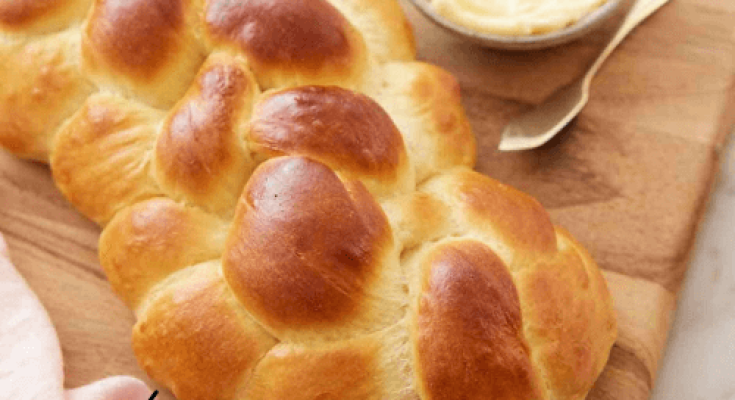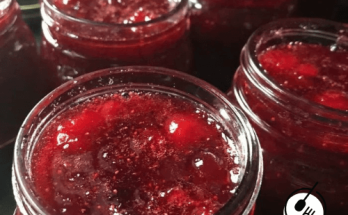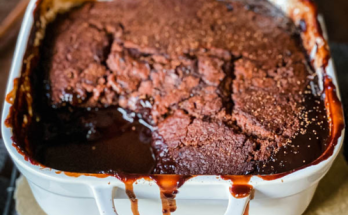This subtly sweet and indulgently luxuriant Challah Bread Recipe loaf is quite pleasingly attaining, both visually-a-rust golden crust-as easy to make, perhaps shockingly so. The soft, braided bread features eggs and oil, adding both tradition and flavor to every bite. It is a loaf of irresistibly tender, airy interior-every bit as enticing on the plate as on the palate-and perhaps quite shockingly easy to create!
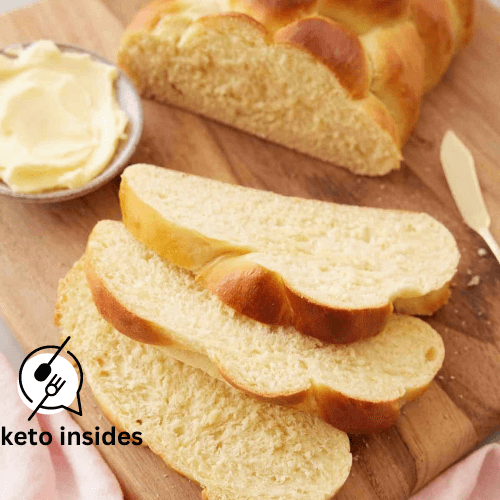
What You Need to Make This Recipe
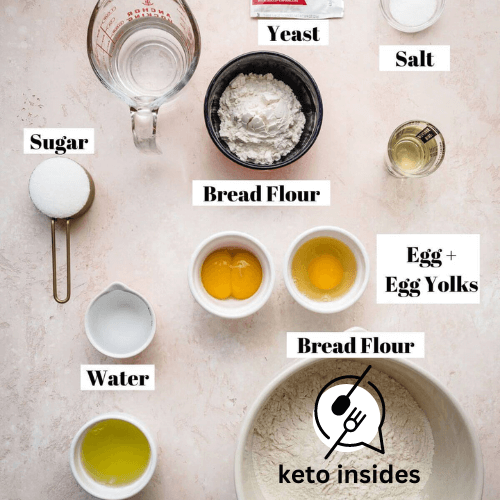
Sugar – The essential agent to activate the yeast and give a mild sweetness to the dough while providing the classic flavor of bread.
Yeast – Always make sure you use the latest package of yeast, because the older package won’t get you the uprising you are looking for.
Flour – There is no such special flour in Challah recipe. All-purpose flour from your pantry will get the job done when it comes to producing a soft and airy Challah.
Oil – I use vegetable oil to give the dough a tender, delicate crumb that keeps the bread moist and flavorful.
Eggs – The richness in the dough comes from a couple of eggs. Plus, the egg whites make an ideal egg wash, creating a beautiful, shiny golden crust.
How to Make Challah Bread Recipe
In a large bowl, or using the bowl of your stand mixer that has been equipped with a dough hook, combine warm water, sugar, and yeast. The secret to making sure that the yeast is active is letting this mixture sit until it becomes frothy.

Add 4 cups of all-purpose flour to this bowl.
Two sets of pictures illustrating how eggs are added to the dough and how the dough lifts with the dough hook.
Mix in eggs, yolk, oil and salt.
Mix on medium-low speed, until it becomes a sticky, elastic dough with some texture but doesn’t have a clean release from the bottom of the bowl. It should want to stick a little bit to the side and then slap back out. After 6 minutes of kneading in the mixer, add the flour one tablespoon at a time as needed. Gather the dough into a ball, and put it in an oiled bowl- just enough oil to coat-but turn the dough to make sure it gets well coated. Cover the bowl, and let it rise in a warm spot, about 75°F, until it has doubled in size.
Set of two images showing dough divided into balls, then one rolled into a log, followed by all six connected at the top.
On a lightly floured surface, turn out the dough and divide it into 6 equal portions. Roll each piece into a 12-inch long rope.
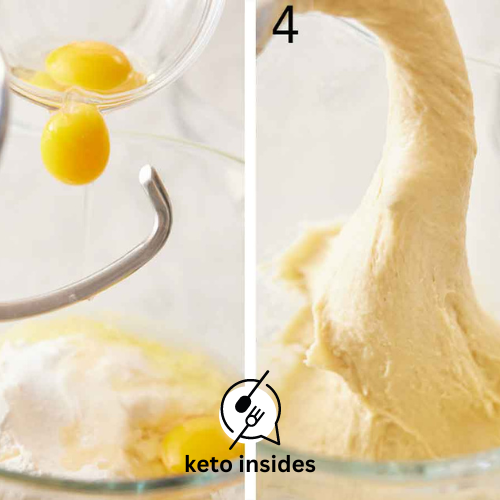
Place the ropes parallel to each other, pinch the ends together, and gently fan them out.
Photo set of two: dough braiding and brushing with egg whites.
Begin braiding the dough by moving the outer right rope over 2 strands toward the center. Then the second-left strand is pulled out and crossed over all the other ropes to the outer right. Next step: cross the outer left strand over 2 strands to the center. Then pull out the second-right strand out to the outer left. Now repeat this braiding pattern until the loaf is completely braided. Tuck ends underneath a little bit; now transfer to a parchment-lined baking sheet. Tightly cover it and let rise another 30 minutes to an hour, until it’s almost doubled in size.
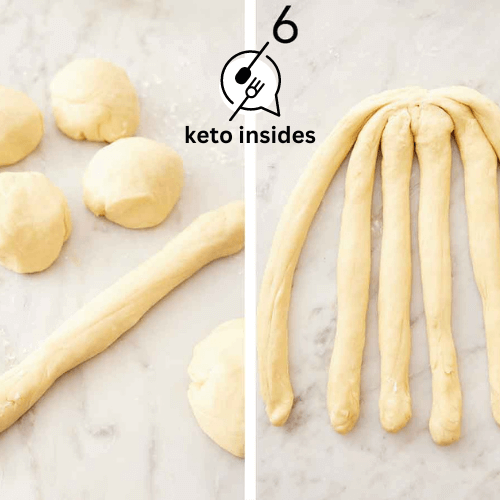
In a small bowl, beat one egg white until foamy. Brush the risen loaf with the egg wash and, if desired, sprinkle with seeds. Bake for 20 to 25 minutes, or until the loaf is a deep golden brown. Cool on a wire rack.
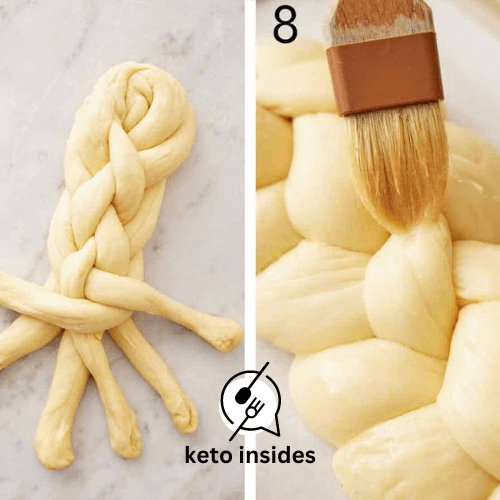
For all those asking around where to buy Challah bread or who sells Challah bread, this traditional sweet challah recipe would be a perfect alternative instead of the commonly bought loaves from the stores. Searching for where to get Challah bread or where to find Challah bread? Why not try this homemade version instead? It rivals any of the store-bought loaves and beats this browsing of where can I buy Challah online. Whether you are looking for that special Challah bread recipe or are interested in trying out some of the more popular variations, such as sourdough recipes, here is a good place to start.
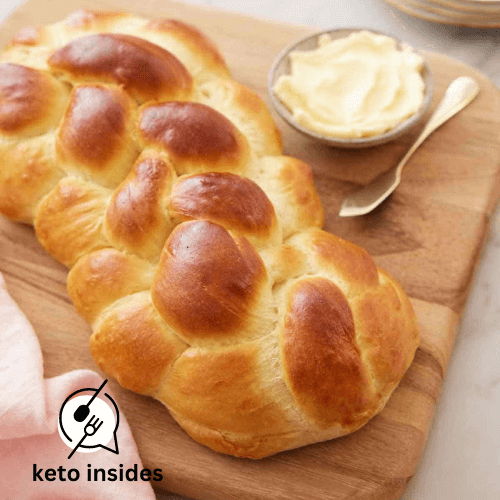
TIPS For Challah Bread Recipe
The flour quantity might differ because of the humidity at your place as well as weather conditions. Begin with 4 cups instead of 4 1/2 to make adjustments based on how sticky the dough
It all depends upon your kitchen temperature to determine how long your dough takes to rise: with an ideal range between 75 and 78 degrees. If your kitchen’s cool, place the dough in the oven with the light on.
Make sure your water is between 110 to 120°F; that’s what you want for yeast operation-not too hot, which kills the yeast, but not hot enough to make it operate.
Avoid too much flour, which is challah’s worst enemy-it makes dough dense instead of light. Measuring flour is really easy when you have a scale, but if you don’t, you just fluff your flour with the spoon, sprinkle it into your measuring cup, and then level it off with the knife.
The most straightforward braid comes from dividing the dough into 3 portions and rolling them into ropes. Then braid them as you do in a traditional 3-strand braid.
For added savory flavor to your challah, you can mix minced garlic or rosemary into the dough. Leftover challah makes fantastic French toast or bread pudding, so don’t let any of that go to waste!
FAQs For Challah Bread
1. Why Challah is different from another bread?
Challah is a traditional Jewish bread, often braided and highly bred with eggs and oil, which generally results in a soft, tender crumb and beautiful golden crust. Unlike many other breads, Challah does not have to contain dairy products so it is parve, then it fits well within the dietary restrictions applied in Jewish cuisine.
2. How much flour do I need to use as starting point
Start with 4 cups of flour. You may have to add more gradually, depending on how humid and sloppy it is outside, but add too much flour at one time and you’ll end up with dough that’s impossibly dense.
3. Do I really need a stand mixer to make Challah?
Of course! As long as you knead the dough by hand. Although the stand mixer with a dough hook does much more rapidly and is easier to work with, the dough is wonderful even when kneaded by hand.
4. Warm water for the yeast How warm should the water be for the yeast?
The water should be between 110°F and 120°F. Too warm, and the yeast will die; too cool and it won’t activate. Use a thermometer for accuracy.
It should be allowed to rise until it has doubled in volume. That generally takes about 1 to 2 hours, depending on how warm your kitchen is. Ideally, it would be at around 75°F to 78°F.
6. My kitchen is cold. What are some things that I can do to help the dough rise?
If your kitchen is just a bit too cold, you can simply put it in your oven with the light on – do remember that the oven needs to be off, of course! The warmth of the light is an excellent opportunity for the dough to rise.
7. My challah bread is so dense!
Normally, the problem of dense bread is usually because of too much flour in the dough. So, measure your flour carefully, or weight it with a kitchen scale. Add the flour gradually-you ought to quit when the dough seems soft but not too sticky.
8. Can I add other flavors to my challah dough?
Absolutely! You can include minced garlic, rosemary, or even other herbs to make it more savory. Sesame and poppy seeds you can sprinkle on top as well as right after applying the egg wash.
9. How would I braid the challah, if I were just starting out?
If braiding still seems too intimidating, start with a 3-strand braid, like braiding hair or rope. As you start to feel confident in your skills, try more complicated braiding techniques-including 4, 6, or even 8 strands.
10. How can I use leftover challah?
It’s wonderful for making French toast, bread pudding, or even croutons. It’s lightly sweet and eggy, which makes it an ideal product for those applications.
11. May I freeze challah dough?
Yes, you can freeze challah dough. After the first rise, shape the dough into a ball or braid it. Wrap tightly and freeze. When you get to the baking day, thaw and let it rise until doubled in size before baking.
12. How long will the baked challah last?
Freshly baked challah may be stored at room temperature for as short as 2 to 3 days in an airtight container. If you keep it frozen, it will last long enough, even up to 3 months, when properly kept. Just wrap it well before freezing.
13. Can I make a sweet challah with this recipe?
Yes! This can be made into yummy challah with minimal addition of sugar or even other ingredients like raisins, honey, or cinnamon to the dough.
14. How can I get challah bread in stores if I don’t want to bake from scratch?
Challah bread can most often be found in most grocery stores, local bakeries, and even on some websites. If you’re looking to buy Challah bread, you can try looking for it at your local bakery or specialty food store. But homemade Challah is pretty straightforward, and you get to control the ingredients and the flavor, so how can that go wrong?
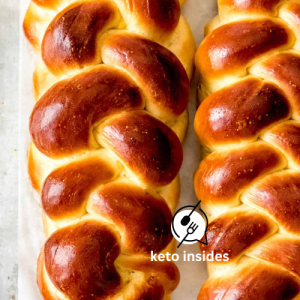
challah bread recipe
Equipment
- Mixing Bowl
- Electric stand mixer
- Large baking sheet
Ingredients
- ¾ cup warm water (110-120F) (180ml)
- ¼ cup sugar (50g)
- 2¼ teaspoons active dry yeast (.25-ounce/7g packet)
- 4 to 4½ cups all-purpose flour (480-540g)
- ⅓ cup vegetable oil (80ml)
- 2 large eggs
- 1 egg yolk (white reserved for egg wash)
- 1 teaspoon salt
- Poppy seeds or sesame seeds for topping (optional)
Instructions
- In a large bowl or the bowl of a stand mixer fitted with a dough hook, combine the warm water, sugar and yeast. Let it rest for about 5 minutes, until it becomes foamy.
- Add flour, oil, eggs, egg yolk, and salt to the bowl. Mix on medium-low speed for 8-10 min until the dough is becoming sticky and elastic. The dough will cling to the bottom of the bowl while pulling away from the sides and slap against the sides of the bowl. If necessary, after 6 minutes, add flour one tablespoon at a time.
- Shape the dough into a ball, place in a lightly oiled bowl, turn to grease the ball, cover the bowl, and allow the dough to rise in a warm, draft-free location (75°) until it has doubled in size, about 1 to 2 hours.
- Transfer the dough to a floured surface after it has risen. Divide the dough into 6 equal portions and roll each into a 12-inch long rope. Lay all 6 ropes parallel to one another, pinch the ends together and fan them out slightly.
- To braid the dough start with the outer right rope and cross that rope over two strands toward the center. Then taking the second from the left strand to the right over all, this one must be placed on the outer right. Next, take the outer left strand and overpass two strands to the center. Then take the second rope from the right and move it to the outer left. Continue this pattern until the whole loaf is braided. Slightly pinch the ends and tuck them underneath. Place the plaited loaf on a parchment paper-lined baking sheet. Loosely cover and let it rise another 30 minutes to an hour, or until almost doubled in size.
- Towards the end of the final rising time, preheat your oven to 350°F. Beat the egg white in a small bowl till frothy. Brush the egg wash on the loaf. Sprinkle with seeds if desired.
- Bake 20 to 25 minutes, or until the loaf is deep golden brown. You can also check for doneness with an instant-read thermometer—the internal temperature should be between 195 and 205 degrees Fahrenheit. Once baked, transfer the loaf to a wire rack to cool completely. Challah is best fresh on the day it is baked, but it may be wrapped tightly in plastic and kept at room temperature for a day or two, or stored in an airtight container for a few days in the fridge.
Notes
Nutrition Facts
- Amount Per ServingCalories221
- % Daily Value *
- Total Fat
4g
7%
- Saturated Fat 1g 5%
- Sodium 265mg 12%
- Potassium 86mg 3%
- Total Carbohydrate
37g
13%
- Dietary Fiber 1g 4%
- Sugars 4g
- Protein 7g 15%
- Calcium 19%
- Iron 3%
* The % Daily Value tells you how much a nutrient in a serving of food contributes to a daily diet. 2,000 calories a day is used for general nutrition advice.

